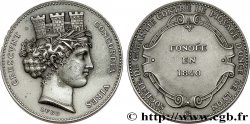bmv_223465 - FRISIA - ANGLO-SAXONS Denier au quatre-feuilles
non disponibile.
Articolo venduto sul nostro negozio (2012)
Prezzo : 390.00 €
Articolo venduto sul nostro negozio (2012)
Prezzo : 390.00 €
Tipo : Denier au quatre-feuilles
Data: c. 710-750
Nome della officina / città: Rhénanie inférieure
Metallo : argento
Diametro : 12,5 mm
Asse di coniazione : 12 h.
Peso : 1,07 g.
Grado di rarità : R3
Commenti sullo stato di conservazione:
Monnaie sur un flan large, avec un bon centrage des deux côtés, mais légèrement ébréché. Usure homogène et patine sombre dans les creux, mettant en valeur les reliefs
N° nelle opere di riferimento :
Diritto
Titolatura diritto : ANÉPIGRAPHE.
Descrittivo diritto : Buste diadémé à gauche avec un nez crochu, le cou perlé ; une croix latine devant le visage et trois globules posés en triangle derrière la nuque.
Rovescio
Titolatura rovescio : ANÉPIGRAPHE.
Descrittivo rovescio : Quatre-feuilles cantonné de trois globules en triangles.
Commento
Malgré les diverses attributions proposées, dans son Numéraire Mérovingien G. Depeyrot ne se prononce pas en mettant les monnaies de ce type dans une série typologique “entrelacs au revers” (cf. pl. 30). Il précise, page 175, que ces “deniers aux entrelacs seraient attribués à Poitiers par d’Amécourt (B. 5995). Pour J. Lafaurie (RN 1996) ces monnaies seraient à attribuer à Maastricht”. P. Grierson et M. Blackburn préfèrent y voir un atelier de la Rhénanie inférieure (p. 508).
La précision selon laquelle pour d'Amécourt “le quatrefeuille doit être attribué à Auxerre et le trèfle à Poitiers” semble assez simpliste (cf. Belfort tome IV, page 281).
Cet exemplaire est d’un style très particulier au droite, avec un nez très crochu, comme sur les B. 5596 et 6698, moins schématique que sur les monnaies rencontrées habituellement.
Despite the various attributions proposed, in his Numéraire Mérovingien G. Depeyrot does not take a position by placing coins of this type in a typological series “interlacing on the reverse” (cf. pl. 30). He specifies, page 175, that these “deniers with interlacing would be attributed to Poitiers by d'Amécourt (B. 5995). For J. Lafaurie (RN 1996) these coins would be attributed to Maastricht”. P. Grierson and M. Blackburn prefer to see a workshop in the Lower Rhineland (p. 508). The clarification according to which for d'Amécourt “the quatrefoil should be attributed to Auxerre and the clover to Poitiers” seems rather simplistic (cf. Belfort volume IV, page 281). This example is of a very particular style on the right, with a very hooked nose, like on B. 5596 and 6698, less schematic than on the coins usually encountered
La précision selon laquelle pour d'Amécourt “le quatrefeuille doit être attribué à Auxerre et le trèfle à Poitiers” semble assez simpliste (cf. Belfort tome IV, page 281).
Cet exemplaire est d’un style très particulier au droite, avec un nez très crochu, comme sur les B. 5596 et 6698, moins schématique que sur les monnaies rencontrées habituellement.
Despite the various attributions proposed, in his Numéraire Mérovingien G. Depeyrot does not take a position by placing coins of this type in a typological series “interlacing on the reverse” (cf. pl. 30). He specifies, page 175, that these “deniers with interlacing would be attributed to Poitiers by d'Amécourt (B. 5995). For J. Lafaurie (RN 1996) these coins would be attributed to Maastricht”. P. Grierson and M. Blackburn prefer to see a workshop in the Lower Rhineland (p. 508). The clarification according to which for d'Amécourt “the quatrefoil should be attributed to Auxerre and the clover to Poitiers” seems rather simplistic (cf. Belfort volume IV, page 281). This example is of a very particular style on the right, with a very hooked nose, like on B. 5596 and 6698, less schematic than on the coins usually encountered








 Segnalare un errore
Segnalare un errore Stampate la pagina
Stampate la pagina Condividi mia selezione
Condividi mia selezione Fai una domanda
Fai una domanda Consegnare / vendere
Consegnare / vendere





